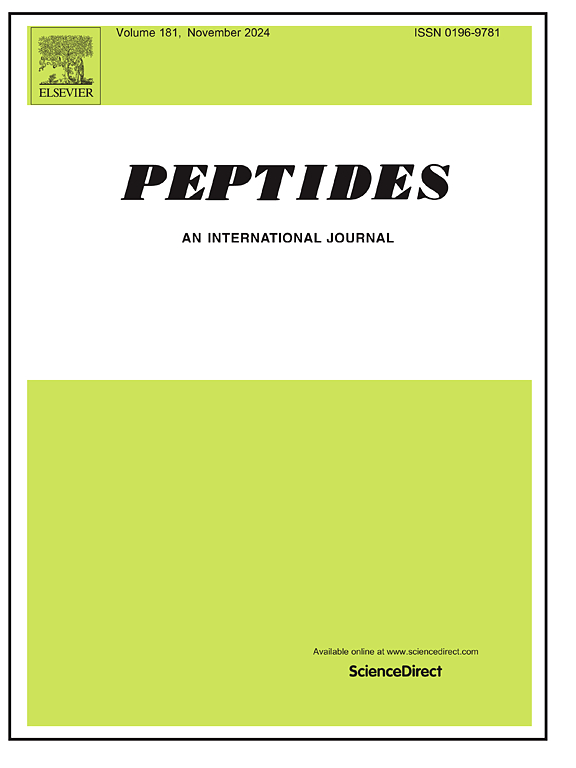The effects of corticotropin-releasing factor (CRF) and urocortins on the noradrenaline (NA) released from the locus coeruleus (LC)
IF 2.9
4区 医学
Q3 BIOCHEMISTRY & MOLECULAR BIOLOGY
引用次数: 0
Abstract
Corticotropin-releasing factor (CRF) activates the hypothalamic-pituitary-adrenal (HPA) axis and stimulates the noradrenergic neurotransmission, both processes being implicated in the pathogenesis of anxiety and depression, but the intimate site and mechanism of interaction of CRF and CRF-related peptides, named urocortins (UCN1, UCN2, UCN3), with noradrenaline (NA) was not fully elucidated yet. Therefore, the aim of the present study was to investigate the actions of CRF and urocortins on the NA released from the rat locus coeruleus (LC), the primary source of NA in the brain, and the participation of CRF receptors (CRF1 and CRF2) in these actions. In order to do so, male Wistar rats were used, their LC were isolated and dissected, and the LC slices were incubated with tritium-labelled NA, superfused and stimulated electrically. During superfusion, the LC slices were treated with CRF, UCN1, UCN2 or UCN3, and, when significant effect was observed, pretreated with selective CRF1 antagonist antalarmin or selective CRF2 antagonist astressin2B. The release of tritium-labelled NA from the LC was determined by liquid scintillation counting. CRF and UCN1 increased significantly the tritium-labelled NA release from the LC, and these effects were reduced by antalarmin, but not by astressin2B. In addition, UCN2, but not UCN3, decreased significantly the tritium-labelled NA release from the LC, and this effect was reversed by astressin2B, but not antalarmin. Our results indicate the existence of two apparently opposing CRF systems in the LC, since activation of CRF1 by CRF and UCN1 stimulated, whereas activation of CRF2 by UCN2 inhibited the NA release.
促肾上腺皮质激素释放因子(CRF)和尿皮质素对脑皮质释放的去甲肾上腺素(NA)的影响。
促肾上腺皮质激素释放因子(CRF)能激活下丘脑-垂体-肾上腺(HPA)轴,刺激去甲肾上腺素能神经递质,这两个过程都与焦虑和抑郁的发病机制有关,但CRF和CRF相关肽(即尿皮质素(UCN1、UCN2、UCN3))与去甲肾上腺素(NA)相互作用的密切部位和机制尚未完全阐明。因此,本研究旨在探究 CRF 和尿皮质素对大鼠脑内 NA 的主要来源--大鼠脑室(LC)释放的 NA 的作用,以及 CRF 受体(CRF1 和 CRF2)在这些作用中的参与情况。为此,研究人员使用雄性 Wistar 大鼠,分离并解剖了它们的 LC,用氚标记的 NA 培养 LC 切片,并对其进行灌注和电刺激。在超灌注过程中,用 CRF、UCN1、UCN2 或 UCN3 处理 LC 切片,并在观察到显著效果时,用选择性 CRF1 拮抗剂 antalarmin 或选择性 CRF2 拮抗剂 astressin2B 进行预处理。通过液体闪烁计数测定氚标记的 NA 从 LC 中的释放量。CRF 和 UCN1 能显著增加胰岛素管中氚标记 NA 的释放,antalarmin 能降低这些效应,但 astressin2B 却不能。此外,UCN2(而非 UCN3)能显著减少 LC 中氚标记 NA 的释放,而 astressin2B(而非 antalarmin)能逆转这种效应。我们的研究结果表明,LC中存在两种明显对立的CRF系统,因为CRF和UCN1激活CRF1会刺激NA的释放,而UCN2激活CRF2会抑制NA的释放。
本文章由计算机程序翻译,如有差异,请以英文原文为准。
求助全文
约1分钟内获得全文
求助全文
来源期刊

Peptides
医学-生化与分子生物学
CiteScore
6.40
自引率
6.70%
发文量
130
审稿时长
28 days
期刊介绍:
Peptides is an international journal presenting original contributions on the biochemistry, physiology and pharmacology of biological active peptides, as well as their functions that relate to gastroenterology, endocrinology, and behavioral effects.
Peptides emphasizes all aspects of high profile peptide research in mammals and non-mammalian vertebrates. Special consideration can be given to plants and invertebrates. Submission of articles with clinical relevance is particularly encouraged.
 求助内容:
求助内容: 应助结果提醒方式:
应助结果提醒方式:


